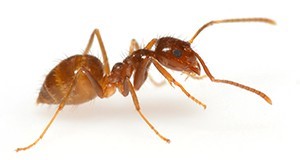Abstract
The tawny crazy ant infests buildings and greenhouses, attacks crops, domestic animals, and honeybee hives, displaces native ant species, and disrupts electrical equipment. This 8-page fact sheet is a major revision that describes how to identify the ant and monitor for infestations. It explains how to eliminate food sources and harborages and presents an integrated pest management plan and specific approaches to control this pest ant. (Note: the tawny crazy ant is a serious pest that multiplies quickly and can easily become an overwhelming problem. If you suspect you have tawny crazy ants, the best approach is to call a licensed pest-control professional for help). Written by Faith Oi, Dawn Calibeo, John Paige III, and Michael Bentley, and published by the UF Department of Entomology and Nematology, September 2016.
References
Bentley, M. T., D.A. Hahn, and F. M. Oi. 2016. "The thermal breadth of Nylanderia fulva (Hymenoptera: Formicidae) is narrower than that of Solenopsis invicta at three thermal ramping rates: 1.0, 0.12, and 0.06°C min-1." Environ. Entomol. DOI: http://dx.doi.org/10.1093/ee/nvw050 First published online: 1 June 2016. https://doi.org/10.1093/ee/nvw050
Gotzek, D., S. G. Brady, R. J. Kallal, and J. S. LaPolla. 2012. "The importance of using multiple approaches for identifying emerging invasive species: The case of the Rasberry crazy ant in the United States." PLoS ONE 7(9): e45314. doi:10.1371/journal.pone.0045314. https://doi.org/10.1371/journal.pone.0045314
LeBrun, E. G., J. Abbott, and L. E. Gilbert. 2013. "Imported crazy ant displaces imported fire ant, reduces and homogenizes grassland ant and arthropod assemblages." Biological Invasions 15: 2429-2442. https://doi.org/10.1007/s10530-013-0463-6
LeBrun, E. G., N. T. Jones, and L. E. Gilbert. 2014. "Chemical warfare among invaders: A detoxification interaction facilitates and ant invasion." Science 343 (6174): 1014-1017. DOI: 10.1126/science.1245833. https://doi.org/10.1126/science.1245833
Sharma, S., J. Warner, and R. H. Scheffrahn. 2014. Tawny Crazy Ant (previously known as Caribbean crazy ant) Nylanderia (formerly Paratrechina) fulva (Mayr) (Insecta: Hymenoptera: Formicidae: Formicinae). EENY-610. Gainesville: University of Florida Institute of Food and Agricultural Sciences. http://edis.ifas.ufl.edu/in1071
Zenner-Polanía, I. 1990. "Biological Aspects of the 'Hormiga Loca' Paratrechina (Nylanderia) fulva (Mayr), in Colombia." pp. 290-297. In: R.K. Vander Meer, K. Jaffe & A. Cedeno [Eds.]. Applied Myrmecology. A World Perspective. Westview Press, Boulder, CO.
Zhao, L., J. Chen, W. A. Jones, D. H. Oi, and B. M. Drees. 2012. "Molecular comparisons suggest Caribbean crazy ant from Florida and Rasberry crazy ant from Texas (Hymentoptera: Formicidae: Nylanderia) are the same species." Environ. Entomol. Volume 41, Issue 4 DOI: 1008-1018 First published online: 1 August 2012. https://doi.org/10.1603/EN11287

